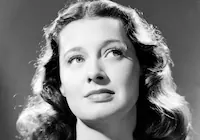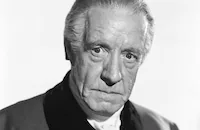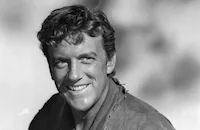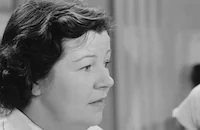Stars in My Crown

Brief Synopsis
Cast & Crew
Jacques Tourneur
Joel Mccrea
Ellen Drew
Dean Stockwell
Alan Hale
Lewis Stone
Film Details
Technical Specs

Synopsis
In 1865, Parson Josiah Doziah Gray arrives in the small Southern town of Walsburg and begins preaching to the townspeople. The town has become so dangerous over the years that Josiah gives his first sermon at the local saloon while holding the patrons at gun point. Josiah leads the effort to build the town's first church, and soon falls in love with and marries Harriet, the church organist. Josiah also befriends Uncle Famous Prill, a black man with whom he often goes fishing. Famous owns mica-rich property, which the nefarious general store owner Lon Backett is trying to wrest from him. Time passes, and the Grays adopt John Kenyon, Josiah's nephew, who has been orphaned. Nearly a decade after his arrival in Walsburg, Josiah learns that Daniel Kalbert Harris, Jr., a recent medical school graduate and the son of one of Josiah's friends, is planning to leave Walsburg because the townspeople are hesitant to accept a young doctor with modern schooling as their physician. The doctor rejects Josiah's piety, and while looking for work outside the town, falls in love with Faith Radmore Samuels, a Walsburg schoolteacher. Daniel tries to persuade Faith to move away with him, but just as they are about to leave, an epidemic of typhoid breaks out and John falls ill. Daniel stays to care for the ill, but he soon comes to suspect that Josiah is unwittingly spreading the disease at his sermons. Hoping to prevent further infections, Josiah consents to the doctor's suggestion that he go into a self-imposed quarantine. When Faith contracts typhoid and is given a poor prognosis by Daniel, Josiah stuns the doctor and others by saving her life through prayer. Humbled by the experience, Daniel apologizes to Josiah for not believing in the healing power of prayer, and the two make amends. Later, Daniel again demonstrates the power of divine guidance when, through prayer, he single-handedly disperses an angry mob seeking to take away Famous' land.

Director

Jacques Tourneur
Cast

Joel Mccrea

Ellen Drew

Dean Stockwell

Alan Hale

Lewis Stone

James Mitchell

Amanda Blake

Juano Hernandez

Charles Kemper

Connie Gilchrist

Ed Begley
Jack Lambert

Arthur Hunnicutt

Marshall Thompson
Norman Ollestad Jr.
Ben Watson
Adeline De Walt Reynolds
Polly Bailey

Jim Arness
Bill Clauson
Ralph Hodges
Chuck Courtney
Jimmy Moss
Jessie Grayson
Wilson Wood
Connie Van
Helen Eby-rock

Margaret Bert
Patsy O'byrne
Carl Petti
Frank Pharr

Howard Mitchell
Buddy Roosevelt
Fred Datig Jr.
Robert Cherry
Baron Lichter
Tex Terry
Snub Pollard
Rhea Mitchell
Blaine Metz
Jessie Arnold
Edmund Glover

Patricia Miller
Victor Kilian
Philo Mccullough
Jim Pierce
Eula Guy
Al Kunde
Alice Richey
Matilda Caldwell
Helen Brown
Crew
Joe David Brown
Jack Dawn
Adolph Deutsch
Margaret Fitts
Cedric Gibbons
Arvid Griffin
Sydney Guilaroff
Eddie Imazu
Al Jennings
Warren Newcombe
Sergei Petschnikoff
Walter Plunkett
Gene Ruggiero
Charles Schoenbaum
Douglas Shearer
Alfred E. Spencer
Robert Tucker
Edwin B. Willis
William H. Wright

Videos
Movie Clip



Trailer
Film Details
Technical Specs

Articles
Stars in My Crown
Director Jacques Tourneur made a career out of his association with producer Val Lewton, which led to work on several creepy horror films for RKO such as Cat People (1942) and I Walked with a Zombie (1943). He established a unique visual style based on his use of moody, ominous lighting schemes. Stars in My Crown, however, was a departure from Tourneur's usual dark style and subject matter. Instead of conveying a sense of foreboding and suspense, it exudes a warmth and optimism not often found in his work.
The central role of the levelheaded Parson Grey who thumps a Bible and carries a gun at the same time was not such a departure for actor Joel McCrea. This dependable leading man made his mark mostly in Westerns like Ride the High Country (1962) and Preston Sturges comedies like Sullivan's Travels (1941). For Stars in My Crown, McCrea had established enough star power to earn a salary of ten thousand dollars a week.
Popular 1940s child actor Dean Stockwell is poignant as the young narrator of the story - John - and he was one of the few child actors who managed to make the successful transition into adult roles. His childhood roles included parts in The Boy with Green Hair (1948) and The Secret Garden (1949). While he always worked with some degree of regularity throughout his career, Stockwell enjoyed a return to prominence as an adult actor in the 1980s with a string of memorable character roles in films like Blue Velvet (1986), Tucker: The Man and His Dream (1988) and Married to the Mob (1988), for which he was nominated for an Academy Award as Best Supporting Actor. He also had a long, successful stint on the science fiction TV series Quantum Leap as the holographic image contact Al.
Some other recognizable faces grace the community of Stars in My Crown. A young Amanda Blake, most famous for her role as saloon keeper Miss Kitty on the long-running Western TV series Gunsmoke, plays the new-doctor-in-town's love interest, Faith. James Arness, who co-starred with Blake in Gunsmoke as Dodge City Marshal Matt Dillon, also appears in a small role as one of Jed Isbell's sons.
Farmer and friend to Parson Grey, Jed Isbell, is played by veteran character actor Alan Hale, who starred in hundreds of films over his five-decade-long career. Incidentally, he was also known as the father of actor Alan Hale, Jr., who bore an uncanny resemblance to his famous dad. Hale, Jr., gained fame playing The Skipper on Gilligan's Island. Stars in My Crown was one of the last films the senior Hale completed before his death in 1950, the year the film was released.
Producer: William H. Wright
Director: Jacques Tourneur
Screenplay: Margaret Fitts
Art Direction: Cedric Gibbons, Gene Ruggiero
Cinematography: Charles E. Schoenbaum
Costume Design: Walter Plunkett
Film Editing: Gene Ruggiero
Original Music: Adolph Deutsch
Principal Cast: Joel McCrea (Josiah Dozier Grey), Ellen Drew (Harriet Gray), Dean Stockwell (John Kenyon), Lewis Stone (Dr. D.K. Harris Sr.), James Mitchell (Dr. D. K. Harris, Jr.), Amanda Blake (Faith Radmore Samuels), Juano Hernandez (Uncle Famous Prill), Connie Gilchrist (Sarah Isbell), Ed Begley (Lon Brackett).
BW-90m.
by Andrea Foshee

Stars in My Crown
Ellen Drew, 1914-2003
She was born Esther Loretta "Terry" Ray on November 23, 1914, in Kansas City, Missouri. The daughter of a barber, her family moved to Chicago when she was still an infant and she lived a very quiet childhood far removed from the glamour of Hollywood. She was encouraged by some friends to enter a beauty contest when she was just 17. After winning, she tried her luck in Hollywood, but found that they were no immediate offers for her particular talents.
She eventually took a waitressing job at C.C. Brown's, a famed Hollywood Boulevard soda fountain, and had virtually abandoned her dreams as a starlet when William Demarest, a popular actor's agent and well-known character actor, spotted her. Demarest arranged a screen test for her at Paramount, and she was promptly placed under contract for $50 a week.
For the first few years, (1936-38), Drew got only bit parts, and was often uncredited. When she finally got prominent billing in the Bing Crosby musical Sing You Sinners (1938), she decided to change her name, from Terry Ray to Ellen Drew. She earned her first major role in Frank Lloyd's If I Were King (1938) opposite Ronald Colman, yet for the most part of her career, rarely rose above "B" material and second leads. Still, she had some fine exceptions: Preston Sturges' enchanting comedy Christmas in July (1940), with Dick Powell; Tay Garnett's lighthearted war romp My Favorite Spy (1942) co-starring Kay Kyser; Julien Duvivier's taut The Imposter (1944), holding her own with a brooding Jean Gabin; and Mark Robson's chilling low-budget chiller Isle of the Dead (1945) opposite Boris Karloff. Drew made some notable television appearances in the late '50s including Perry Mason and The Barbara Stanwyck Show, before retiring from the entertainment industry. She is survived by her son David; five grandchildren; and five great-grandchildren.
by Michael T. Toole
Ellen Drew, 1914-2003
Quotes
Trivia
Notes
Although Lionel Barrymore is listed in the Call Bureau Cast Service as the narrator, the film was actually narrated by Marshall Thompson. According to a February 1948 Los Angeles Times news item, Robert Taylor was originally set to star in the film. A March 1948 Hollywood Reporter news item noted that William Wright was set to direct the picture, and that Van Heflin was being considered for the male lead. The film received a number of awards for exellence by many organizations, including an official citation of merit by the National Conference of Christians and Jews, and a special plaque proclaiming Stars in My Crown as the "Best Picture of the Year" by the editor of the Christian Herald magazine.















